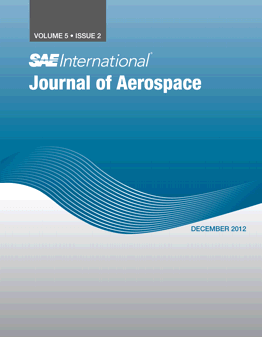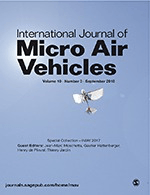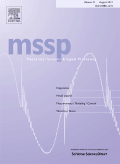
International Journal of Aeronautical and Space Sciences
Scope & Guideline
Pioneering Insights in Aerospace Engineering
Introduction
Aims and Scopes
- Aerodynamics and Fluid Dynamics:
Research related to the flow of air around aircraft and the effects of fluid dynamics on performance, stability, and control systems. - Propulsion and Engine Technology:
Studies focusing on the development and optimization of various propulsion systems, including rocket engines, turbofans, and hybrid propulsion technologies. - Control Systems and Automation:
Innovations in control strategies for aircraft and spacecraft, including adaptive control, fault-tolerant control, and guidance algorithms. - Structural Engineering and Materials:
Investigations into the structural integrity of aerospace components, including lightweight materials, composite structures, and impact resistance. - Urban Air Mobility and Unmanned Systems:
Research addressing the challenges and technologies related to urban air mobility, drone operations, and autonomous flight systems. - Space Missions and Technology:
Exploration of technologies and methodologies for space missions, including satellite design, trajectory optimization, and space debris management. - Simulation and Modeling:
Development of computational models for predicting performance, simulating dynamics, and analyzing aerodynamics of various aerospace systems.
Trending and Emerging
- Machine Learning and Artificial Intelligence in Aerospace:
An increasing number of studies are focusing on the application of AI and machine learning techniques to enhance decision-making, control systems, and predictive maintenance in aviation and space technologies. - Sustainable Aviation Technologies:
Research is trending towards sustainable practices in aviation, including electric and hybrid propulsion systems, noise reduction technologies, and environmentally friendly materials. - Urban Air Mobility Solutions:
With the rise of urban air mobility, there is a growing focus on technologies for air taxis, drone delivery systems, and the associated infrastructure for efficient urban airspace management. - Advanced Simulation Techniques:
Innovative methodologies for dynamic simulation, modeling, and real-time analysis of flight systems are gaining traction, reflecting the need for more sophisticated predictive tools. - Space Debris and Mitigation Strategies:
As space activities increase, research on the characterization, tracking, and mitigation of space debris is becoming increasingly important to ensure sustainable space operations. - Integration of Multidisciplinary Approaches:
There is a notable trend towards multidisciplinary design optimization that combines various engineering disciplines to enhance the performance and efficiency of aerospace systems.
Declining or Waning
- Conventional Aeronautical Structures:
Research focused on traditional aircraft structures is declining, likely due to the shift towards innovative materials and designs that enhance performance and reduce weight. - Basic Aerodynamics Principles:
Studies that solely address fundamental aerodynamics without application to modern technologies or advanced materials appear to be less frequent as the field progresses. - Static Flight Analysis:
Static analyses of flight dynamics are being overshadowed by dynamic, real-time simulations that account for variable conditions and advanced control strategies. - Historical Studies in Aeronautics:
Research that primarily revisits historical advancements in aeronautics is diminishing, as the focus shifts towards contemporary challenges and future technologies. - Generalized UAV Applications:
While UAV technology is prominent, specific generalized applications without innovative approaches or specific use cases are seeing reduced publication frequency.
Similar Journals

Journal of Aeronautics Astronautics and Aviation
Empowering the Next Generation of Aerospace ProfessionalsJournal of Aeronautics Astronautics and Aviation, published by the Aeronautical & Astronautical Society Republic of China, is a premier scholarly journal dedicated to advancing knowledge in the dynamic fields of aerospace engineering and space sciences. Operating under the ISSN 1990-7710, this journal plays a pivotal role in disseminating innovative research and practice-oriented studies that address both theoretical and applicative aspects of aeronautics and astronautics. With an impressive history spanning from 2006 to 2024, the journal has established itself as a valuable resource for researchers, professionals, and students alike, featuring contributions that reflect the latest developments and trends within the industry. In the latest rankings, it holds a Q3 classification in Aerospace Engineering and Q4 in Space and Planetary Science, indicating its growing influence despite its niche scope. With an open access model that facilitates widespread readership, the Journal of Aeronautics Astronautics and Aviation strives to foster collaboration and knowledge sharing in these ever-evolving scientific domains.

Advances in Aircraft and Spacecraft Science
Exploring the Frontiers of Flight and Space ExplorationAdvances in Aircraft and Spacecraft Science is a distinguished journal published by TECHNO-PRESS, focusing on the rapidly evolving fields of aerospace engineering and fluid dynamics. With an ISSN of 2287-528X and an E-ISSN of 2287-5271, this journal is an invaluable resource for researchers, professionals, and students dedicated to advancing knowledge in aircraft and spacecraft technologies. Established in 2014, the journal is committed to disseminating high-quality research findings and innovative methodologies, ensuring that cutting-edge studies can be accessed globally. Despite its current position in the Q4 category for both aerospace engineering and fluid flow transfer processes, it continues to carve a niche in the academic landscape, with Scopus rankings highlighting its contribution to these fields. Operating from South Korea, Advances in Aircraft and Spacecraft Science aims to inspire collaboration and knowledge-sharing among scholars, fostering advancements that drive the aerospace industry forward.

International Journal of Aviation Aeronautics and Aerospace
Elevating Research in Aviation and Aerospace InnovationInternational Journal of Aviation Aeronautics and Aerospace, published by Embry-Riddle Aeronautical University, serves as a pivotal platform for the dissemination of innovative research in the fields of aerospace engineering, civil and structural engineering, and safety, risk, reliability, and quality. With an ISSN of 2374-6793 and designated as an open access journal since 2014, it enables unhindered global access to its scholarly content, fostering collaboration among researchers, professionals, and students in the aviation sector. The journal's presence spans from 2014 to 2024 and is recognized within the Q3 category across multiple engineering domains according to recent metrics. Despite its emerging status, it holds respectable rankings in Scopus, demonstrating its relevance and contribution to the academic community, particularly in dynamic engineering sectors. It is an essential resource for anyone looking to enhance their understanding of advancements and challenges in aviation and aerospace solutions.

SAE International Journal of Aerospace
Fostering the Future of Aerospace Technologies.The SAE International Journal of Aerospace, published by SAE International, serves as a critical platform for innovative research and advancements within the field of aerospace engineering. With an ISSN of 1946-3855 and an E-ISSN of 1946-3901, this esteemed journal contributes significantly to the body of knowledge in the aerospace sector, boasting a convergence span from 2008 to 2024. While currently categorized in Q4 of Aerospace Engineering, the journal is dedicated to fostering emerging ideas, technologies, and methodologies that could eventually elevate its standing. Although it does not offer open access options, the journal ensures wide dissemination of its well-curated articles to aid researchers, professionals, and students in staying abreast of the latest developments and trends. Given its distinct focus and commitment to the aerospace community, the SAE International Journal of Aerospace plays an essential role in bridging theory and practice, making it a valuable resource for those within this vital and evolving field.

International Journal of Micro Air Vehicles
Pioneering the Future of MAV TechnologyThe International Journal of Micro Air Vehicles, published by SAGE Publications Ltd, stands as a pioneering platform for cutting-edge research in the rapidly evolving field of micro air vehicle (MAV) technology. With an ISSN of 1756-8293 and an E-ISSN of 1756-8307, this journal caters to a diverse readership, including aerospace engineers, researchers, and industry professionals who are at the forefront of innovation in aerospace engineering. It holds a commendable position within the Q3 category of Aerospace Engineering for 2023 and is ranked 65th out of 153 in Scopus, placing it in the 57th percentile among its peers. As a vital resource since its inception in 2010, the journal emphasizes advancements in design, performance, and applications of MAVs, while facilitating knowledge sharing and collaboration across disciplines. Although it operates on a subscription model, the journal ensures accessibility of pivotal research findings for professionals and scholars alike, aiming to shape the future of aerospace applications through rigorous academic inquiry.

Journal of the Korean Society for Aeronautical and Space Sciences
Unveiling Breakthroughs in Space ScienceThe Journal of the Korean Society for Aeronautical and Space Sciences is a dedicated platform for the dissemination of cutting-edge research in the fields of aerospace engineering and space sciences. Published by the esteemed Korean Society for Aeronautical & Space Sciences, this journal aims to bring together innovative findings and technological advancements from around the globe, thereby contributing to the ongoing development of the aerospace sector. Operating from South Korea, the journal holds an ISSN of 1225-1348 and an E-ISSN of 2287-6871, catering to both print and digital scholarly communication. Although categorized in Q4 within the Aerospace Engineering segment and ranked 139 out of 153 on Scopus, the journal plays a crucial role in fostering research collaboration and knowledge exchange among professionals, researchers, and students alike. With converged years from 2019 to 2024, it continuously seeks to enhance its contributions to the academic community through rigorous peer review and publication of original research. Given the evolution of aerospace technologies, this journal is vital for anyone involved in aeronautical research, ensuring that their work reaches the right audience.

JOURNAL OF THE ASTRONAUTICAL SCIENCES
Connecting Ideas and Discoveries in AstronauticsJOURNAL OF THE ASTRONAUTICAL SCIENCES, published by Springer Heidelberg, serves as a leading platform dedicated to advancing the fields of aerospace engineering and planetary science. With an ISSN of 0021-9142 and an E-ISSN of 2195-0571, this journal has established a significant presence within the academic community, evidenced by its categorization in the Q2 and Q3 quartiles for 2023, positioning it among the top publications in its field. The journal encompasses a spectrum of research that spans from innovative aerospace technologies to the exploration of planetary systems, reflecting its rich scope developed since its inception in 1969. Although not Open Access, it provides vital contributions to ongoing discussions in aerospace research, appealing to researchers, professionals, and students eager to deepen their understanding of astronautics. With a notable impact factor and rankings in Scopus—66th in Aerospace Engineering and 64th in Space and Planetary Science—this journal continues to be a pivotal resource for those engaged in the exploration and utilization of space.

MECHANICAL SYSTEMS AND SIGNAL PROCESSING
Transforming engineering through cutting-edge research.MECHANICAL SYSTEMS AND SIGNAL PROCESSING, published by Academic Press Ltd - Elsevier Science Ltd, is a leading journal that bridges multiple critical fields, including Aerospace Engineering, Civil and Structural Engineering, Computer Science Applications, Control and Systems Engineering, Mechanical Engineering, and Signal Processing. Established in 1987, this esteemed journal serves as an invaluable resource for researchers, professionals, and students seeking to advance the understanding of mechanical systems and their intimate relationship with signal processing techniques. With an impressive impact factor and consistently ranked in the Q1 category across various engineering and computer science disciplines, it offers rigorous peer-reviewed articles that contribute significantly to innovation and methodological advancements in the field. Although it does not currently offer Open Access options, its publication in the United States ensures a wide dissemination of high-quality research that shapes the future of engineering. The journal's convergence until 2025 promises to foster enduring discussions and collaborations that will continue to push the boundaries of technology and engineering applications.

AIRCRAFT ENGINEERING AND AEROSPACE TECHNOLOGY
Bridging theory and practice in aerospace technology.AIRCRAFT ENGINEERING AND AEROSPACE TECHNOLOGY, published by Emerald Group Publishing Ltd, is a leading peer-reviewed journal dedicated to advancing the fields of aerospace engineering and technology. With a strong emphasis on innovative research, the journal aims to bridge theoretical developments and practical applications within the aerospace sector. Although the journal does not currently offer open access, it continues to enrich the academic community's understanding of aircraft design, maintenance, and engineering processes, making it a crucial resource for researchers, professionals, and students alike. By fostering a rigorous dialogue among experts, AIRCRAFT ENGINEERING AND AEROSPACE TECHNOLOGY ensures the dissemination of cutting-edge findings and promotes sustainable practices in the aerospace industry, highlighted by its commitment to high-quality scholarship.

Journal of Aerospace Information Systems
Advancing the Future of Aerospace TechnologyJournal of Aerospace Information Systems, published by the American Institute of Aeronautics and Astronautics, is a premier scholarly platform dedicated to advancing the interdisciplinary field of aerospace information systems. With a focus on innovative research and practical applications, this journal supports the dynamic integration of aerospace engineering, computer science, and electrical engineering. Positioned in Q2 quartiles for 2023 in its respective categories, it ranks notably in Aerospace Engineering (#52/153) and Electrical and Electronic Engineering (#357/797), indicating its significant influence within the scientific community. Research published within its pages addresses a diverse range of technological advancements and applications that are vital for the development of contemporary aerospace systems. As an open-access journal, it facilitates broader dissemination of knowledge, allowing researchers, professionals, and students to engage with cutting-edge discoveries and methodologies. With its competitive impact and commitment to fostering innovation, the Journal of Aerospace Information Systems is an essential resource for anyone involved in the burgeoning field of aerospace technology.